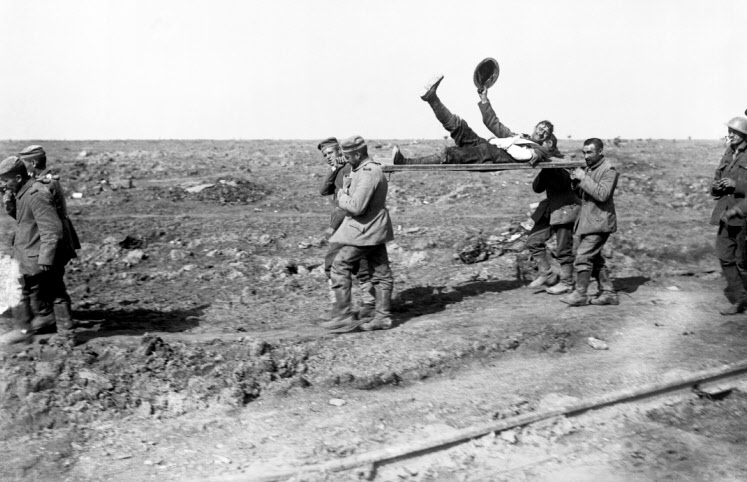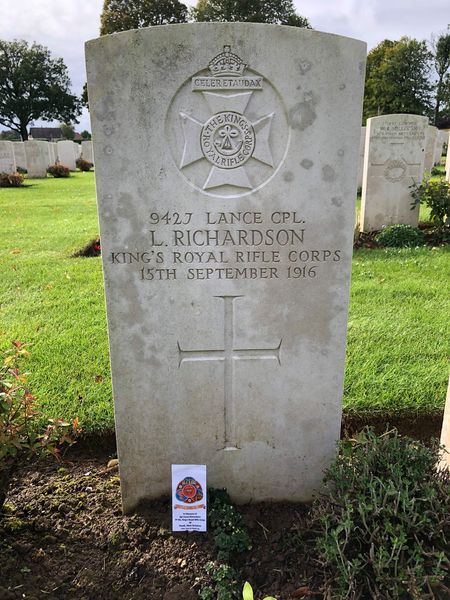
Lionel Richardson was born in Ossett in spring 1890, the second youngest child and fifth son of ten children born to miner John Richardson and his wife Hannah (nee Smales), who married at St. Mary’s Church, Hunslet, Leeds on the 24th March 1873.
By 1891 John, Hannah and their nine children were living at Bennett’s Buildings on Owl Lane Ossett, adjacent to the Royal Oak, in one of a terrace of dwellings which came to be known as “The Barracks”. All of the Richardson children were born in Leeds with the exception of Lionel, who was born in Ossett, almost certainly at Bennett’s Buildings.
Sadly John Richardson died in late 1894, aged just 44 years, leaving Hannah aged 41, a widow with ten children, including the youngest, Lillian who was born in summer 1893. She would have few memories of her father. By the time of his death, the couple appear to have moved to Dewsbury, and in 1901 Hannah was living at 8, Lawson Street Dewsbury with nine of her children, aged between 7 and 27 years. By this time Lionel was 11 years old.
By 1911 Lionel was serving with the British Army Infantry somewhere in India. On the 18th August 1915 Lionel, aged 25 years, a Rifleman in the King’s Royal Rifles was living at 13, Back Lawson Street, Dewsbury. On the same day at the church of St. Philip the Apostle, Dewsbury, he married 23 year-old spinster, Ethel Newsome, of the same address. Both were children of coal miners. Lionel and Ethel appear not to have had children.
Thirteen months after his marriage Sergeant Rifleman, 9427, Lionel Richardson was killed in action on the 15th September 1916 whilst serving with the 9th Battalion the King’s Royal Rifle Corps. His army service record has not survived, but it is known that he enlisted at Huddersfield and served in the 3rd and the 4th battalions of the Regiment before joining the 9th battalion. His service number suggests that he enlisted in 1910 or early 1911 and it seems likely that his India posting in 1911 may have been his first. He was posthumously awarded the British and Victory medals and the 1914-15 Star, indicating that he served in a theatre of war before 1st January 1916.
In August 1914 the 3rd Battalion of the King’s Royal Rifle Corps was in Meerut, India and returned to England in November 1914. The 4th Battalion was also in Gharial, India and returned to England at the same time. These regular units from the further garrisons of Empire arrived back in England, having been recalled soon after the declaration of war, but many having waited until a Territorial unit had gone out to replace them, they were formed up into three Divisions, numbered 27th to 29th. The 27th was formed at Magdalen Hill Camp near Winchester in November-December 1914 and was soon rushed as a much-needed reinforcement to France. Shortage of some types of units was filled by Territorial units taken from other Divisions. The 27th Division, of which the 3rd and 4th Royal Rifle Corps was a part, embarked at Southampton and landed at Le Havre between the 20th to 23rd December 1914 and then moved to concentrate in the area between Aire and Arques.
On the 18th/19th November 1915, the 27th Division, including the 3rd/4th Battalion of the Rifles, were posted to Salonika, Greece, but in the absence of his army service record it is not at all certain that Lionel Richardson sailed with them. He will, however, have taken part in the 2nd Battle of Ypres in April/May 1915.
Lionel may have been serving with the 9th Battalion at the time of his death and this service battalion landed at Boulogne, France on the 20th May 1915 with the 41st Brigade in 14th (Light) Division, so Lionel could not have joined them before this date, which was 3 months before his marriage.
At first this Division was numbered the 8th (Light) Division, but as more regular army units became available to create a Division, they were given precedence and this was renumbered as the 14th (Light) Division. Initially without equipment or arms of any kind, the recruits were judged to be ready by May 1915, although its move to the fighting front was delayed by lack of rifle and artillery ammunition. The 14th (Light) Division served on the Western Front throughout the war. As a regular soldier it is likely that Lionel joined the 9th Battalion, sometime after May 1915, to provide them with much needed experience. He may have been promoted to Sergeant about the same time.
In 1915 the 14th (Light) Division took part in the Action of Hooge (2nd Ypres), in which the Division had the misfortune to be the first to be attacked by German flamethrower. Later in 1915 the Division was involved in the Second Attack on Bellewaarde in September 1915. In 1916 it participated in the battles of the Somme at Delville Wood (July – early September 1916).
This action was followed on 15th to the 22nd September 1916 by the Battle of Flers-Courcelette. It was here, on the first day of this battle on the Somme, that Sergeant, 9427, Lionel Richardson was killed in action. The Commonwealth War Graves Commission records that Lionel was serving with the 3rd Battalion King’s Royal Rifle Corps whereas the War Office list “UK, Soldiers Died in the Great War” records him in the 9th Battalion. The record also shows that at one time he served with the 4th Battalion King’s Royal Rifle Corps. No matter, the 3rd, 4th and 9th Battalions all took part in this battle on the day of his death.

Above: British wounded being carried by German PoWs, September 15th 1916 at the Battle of Flers-Courcelette.
Lionel Richardson was one of eleven Ossett men killed in the Battle of Flers-Courcelette between the 15th and 22nd September 1916, including seven men with KOYLI, two men with the Duke of Wellington’s and two men with the King’s Royal Rifle Corps.
Sergeant Lionel Richardson is remembered at Delville Wood Cemetery, Longueval, at Plot V.I.1. Delville Wood, also known as Devil’s Wood, which was the scene of heavy fighting during the 1916 Battle of the Somme and again in 1918. The cemetery was created after the Armistice south of the wood, on the south side of the road from Longueval to Ginchy. Graves were brought there from surrounding battlefields and smaller cemeteries nearby. Located near Longueval, France, Delville Wood Cemetery is the third largest cemetery in the Somme battlefield area. It is the final resting place of over 5,500 servicemen of the First World War, of whom more than 3,500 remain unidentified. Most of those buried died in July, August and September 1916.
Until now Lionel Richardson has not been remembered on any Ossett War Memorial or Roll of Honour.
We are indebted for additional research by Andrea Hartley, Ossett Through The Ages (OTTA), who first brought this brave Ossett soldier to our attention.

Commonwealth War Graves Commission Headstone (Photograph courtesy of Mark Smith)
References:
1. Commonwealth War Graves Commission